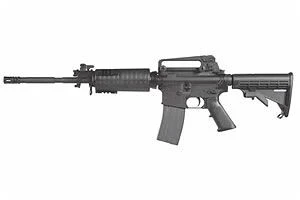Bushmaster Gas Piston 90294 vs Johnson Automatics 1941
Put rifles head to head to compare caliber and more.
|
$1110.50
|
vs |
$0.00
|
| Rifles | Bushmaster Gas Piston 90294 | Johnson Automatics 1941 |
|---|---|---|
| Summary | ||
| Rating | ||
| Rank | ||
| Action | Semi-Automatic | |
| Caliber | .223 Remington | .30-06 Springfield |
| Capacity | 17+1 | |
| Barrel Length | 22" Heavy Barrel | |
| Finish | Black | |
| Gun Type | Semi-Automatic | |
| Details | ||
| Brand | Bushmaster | |
| Reviews | See 2 Reviews | N/A |
| Prices | ||
| MSRP | $1,081.50 | $0.00 |
| Used Price | $757.05 | $0.00 |
| Sale Price | $973.35 | $0.00 |
Rifles Descriptions
Bushmaster Gas Piston 90294
The Bushmaster Gas Piston System Rifles bring new levels of reliability to the “AR” type rifle platform by eliminating carbon build up, gas leaks and heat within the Upper Receiver. The Gas Piston System operates by tapping gas pressure off the barrel much like the systems found on AK-47s and FALs * Functions with a wider range of ammunition - less gas pressure - lower cyclic rate * Offers improved reliability and control - with cleaner operation and reduced recoil * Keeps carbon build up and powder residue from reaching - and fouling the Upper Receiver and Bolt Carrier * A Detented Plug in the Gas Block allows easy cleaning of the Systems’ Hard Chrome Plated Piston
Johnson Automatics 1941
The Model 1941 Johnson rifle (recoil operated) was designed in 1939 by American designer of firearms Melvin Johnson and made by Johnson Automatics, Inc. Around 70,000 of them were made for use in WWII. The rifle use 10 round fixed rotary magazine that could be quickly reloaded using two clips of .30 Caliber M2 Ball ammunition. Stock is a two-piece stock with pistol grip. The theoretical cyclic rate of fire of the Johnson Semi-Automatic Rifle is 600 rounds per minute. The deliverable rate of fire is limited only by the dexterity of the operator. Starting with a fully loaded magazine. ten aimed rounds can be fired in ten seconds. The approximate maximum rate of aimed fire is forty rounds a minute. The barrel is exposed to the air for its entire length, allowing the most eff1cient air cooling by the natural radiation of barrel heat. In practice it is impossible to overheat the barrel. The bolt is 5 inches long. At the front end are eight circumferential lugs, evenly spaced in nine segments around the head of the bolt, one of which is removed for the extractor. The face of the bolt is conventional. The operation of charging the ten-round capacity rotary magazine may be carried out with the bolt open or closed, or with cartridges already in the magazine. The magazine is charged from standard clips (chargers) or it can be charged by inserting individual rounds one at a time. The hinged magazine cover is situated on the right side of the receiver just below and parallel to the ejection port. The charging port is equipped with clip seats (charger guides) into which the clip is inserted horizontally. The cartridges are stripped from the clip and pressed into the magazine in the usual manner by the even pressure of the thumb of the right hand. The cartridges load counter clockwise and feed clockwise. Melvin Johnson was lobbying heavily for adoption of his rifle by U.S. Army but Army decided to go with the M1 rifle developed by Springfield Armory. In WWII the Model 1941 Johnson rifle was used by Marines in the early days of the Pacific fighting, by Free French military and later in the 1961 Bay of Pigs invasion by the anti-Castro Brigade 2506.



